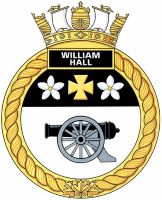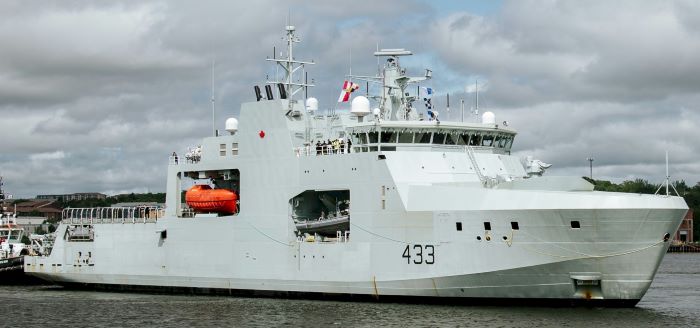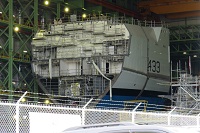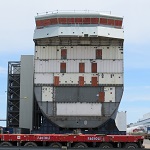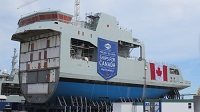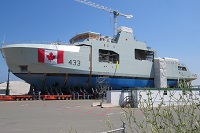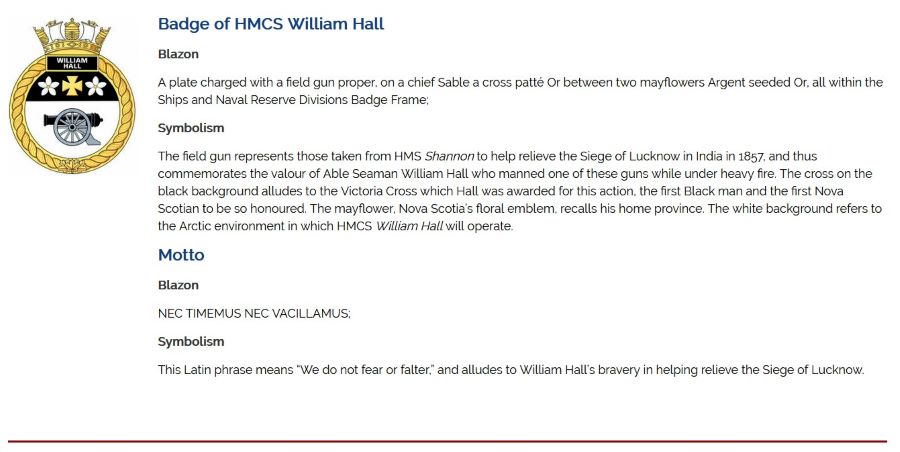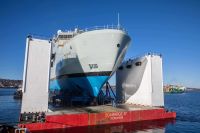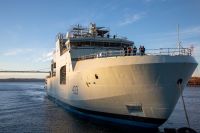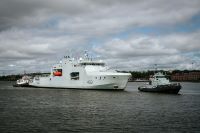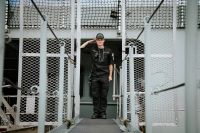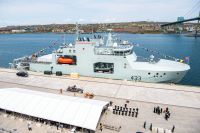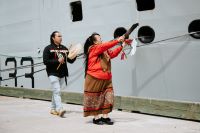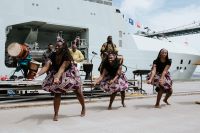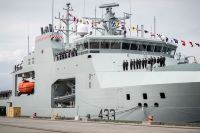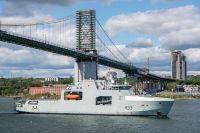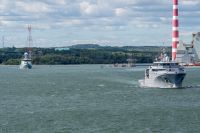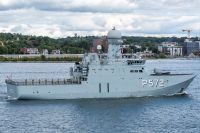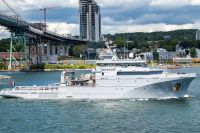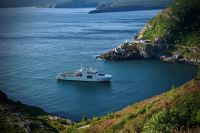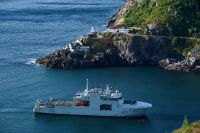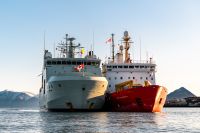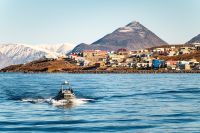|
HMCS WILLIAM HALL 433
Harry DeWolf Class Arctic and Offshore Patrol Vessel
On 27 Nov 2022, the future HMCS WILLIAM HALL was floated up in Bedford Basin, Halifax, NS.
On 28 Apr 2023 the official Naming Ceremony of the future HMCS WILLIAM HALL, the fourth Arctic and Offshore Patrol Ship (AOPS) being built at the Halifax Shipyard for the Royal Canadian Navy (RCN), took place. The son of former American slaves, William Hall was the first Black person, the first Nova Scotian and one of the first Canadians to receive the British Empire’s highest award for bravery, the Victoria Cross, for his bravery during the Seige of Lucknow during the Indian Rebellion of 1857. The son of former American slaves, Hall was born in 1827 at Horton, Nova Scotia, where he also attended school. He grew up during the age of wooden ships, when many boys dreamed of travelling the world in sailing vessels. As a young man, Hall worked in shipyards at Hantsport for several years, before going to sea on merchant ships and joining the Royal Navy in 1852.
“Conditions were harrowing,” said the Honourable Anita Anand, Minister of National Defence, at the ceremony. “Somehow managing to evade the barrage of enemy fire as their friends and shipmates fell all around them, in the end—of His Majesty’s Ship Shannon crew—only Hall and another officer were left standing.”
On 31 Aug 2023, WILLIAM HALL was accepted by the RCN from the builder, 2 months ahead of schedule. She was Commissioned 16 May 2024 at Halifax, NS.
On 03 Jun 2024, HMCS WILLIAM HALL arrived in La Havre, France becoming the first AOPV to complete a transatlantic voyage. The WILLIAM HALL will take part in Operation Distinction commemorating the 80th anniversary of D-Day.
On 14 May 2025, HMCS WILLIAM HALL departed Halifax for a 6 week deployment as part of OPERATION CARIBBE. During her deployment she had port vists to San Juan, Puerto Rico and Basseterra, St. Kitts and Nevis.
On 18 Aug 2025, HMCS WILLIAM HALL departed Halifax for Operation Op NANOOK-TUUGAALIK in Canada's Arctic. She returned to Halifax on 04 Oct 2025 after sailing 8,497 nautical miles through Canada’s Eastern Arctic, navigating the Northwest Passage, and spending 46 days at sea.
Photos and Documents Ship's Company Photos
Photos and Documents
(BG01-BG03) The future HMCS WILLIAM HALL at the Irving Shipyards, Halifax, with her center and stern mega blocks positioned for joining together - 10 Jun 2022. The forward mega block is under construction. (BG04) The future HMCS WILLIAM HALL at the Irving Shipyards, Halifax, with her forward block positioned for joining - 06 Aug 2022 Courtesy of Barry Gerrard
WH000 (WH000) The badge of HMCS WILLIAM HALL, its meaning, and the ship's motto
(WH001) The future HMCS WILLIAM HALL in Bedford Basin shortly before being floated-up - 28 Nov 2022 // DND/RCN photo (WH002) The future HMCS WILLIAM HALL under tow after being floated-up in Bedford Basin, Halifax, NS on 28 Nov 2022 // DND/RCN photo
(WH003 - WH005) The future HMCS WILLIAM HALL was delivered to and accept by the RCN on 30 Aug 2023 Source: RCN's Facebook page
(WH006-WH009) The Commissioning of HMCS WILLIAM HALL Source: RCN's Facebook page
Operation NANOOK-TUUGAALIK 2025
(WH010-WH011) HMCS WILLIAM HALL departs Halifax with HDMS LAUGE KOCH (Royal Danish Navy) and FS GARONNE (Marine Nationale) for exercises in the Labrador Sea before navigating the Northwest Passage and taking part in Op NANOOK-TUUGAALIK and in support of the RCAF, CA, and Canadian Rangers on Operation NANOOK-NUNAKPUT (WH012) HDMS LAUGE KOCH of the Royal Danish Navy (WH013) FS GARONNE of the Marine nationale.
(WH014 - WH015) HMCS WILLIAM HALL arriving at St. John, NL for a port visit during enroute to the Labrador Sea - 27 Aug 2025 // Photographer: Len Cowley // © Len Cowley 2025 // Courtesy of Len Cowley (WH016 - WH017) HMCS WILLIAM HALL at Pond Inlet, Baffin Island 07 Sep 2025 // Photographer: Helen Annie Inuutiq // © Helen Annie Inuutiq 2025 // Courtesy of Helen Annie Inuutiq
(WH018) HMCS WILLIAM HALL and CCGS PIERRE RADISSON at anchor together during Op NANOOK-NUNAKPUT in Pond Inlet, Nunavut, on September 7, 2025 // Photographer: Master Corporal Antoine Brochu, Canadian Armed Forces Combat Camera (WH019) Members from HMCS WILLIAM HALL operate rigid hull inflatable boats during Operation NANOOK-NUNAKPUT 07 Sep 2025 // // Photographer: Master Corporal Antoine Brochu, Canadian Armed Forces Combat Camera
|

